City Cycling in Kyoto, or How to Make a Fully Equipped Bike for $300
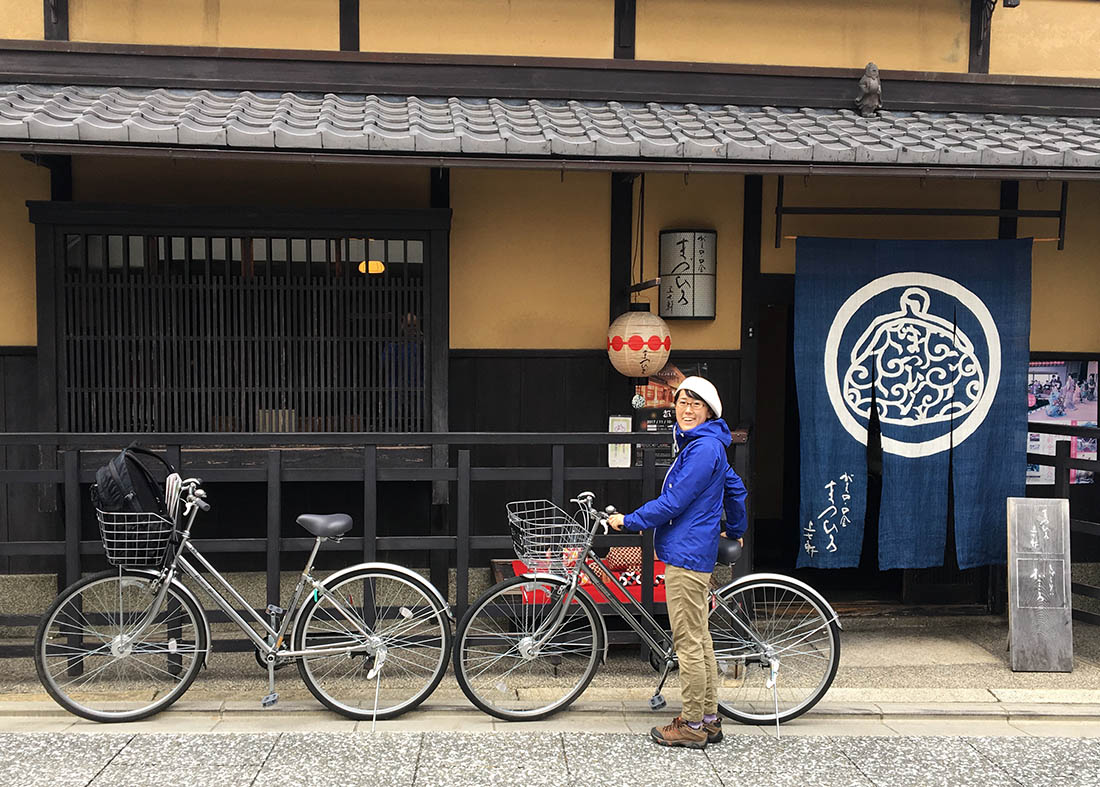
During a recent visit to Kyoto, we rented bikes for a day. Cycling is a great way to get around this beautiful old city, and it also presented an opportunity to experience Japanese city bikes.
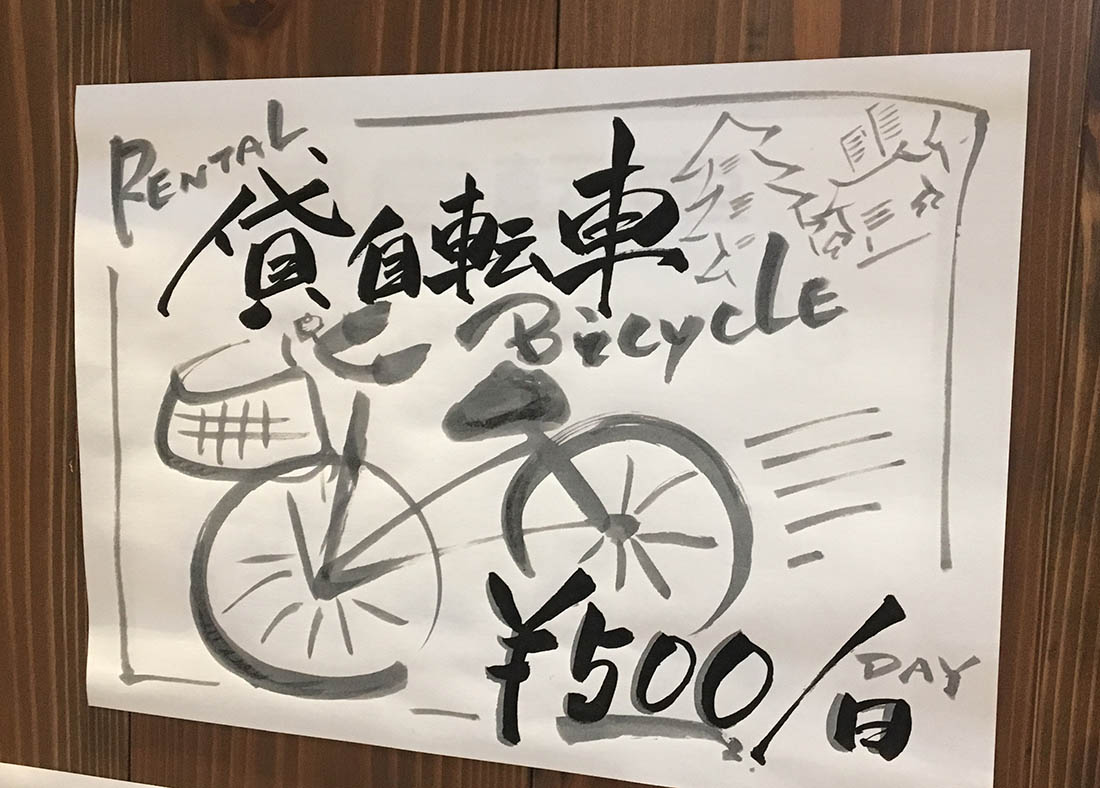
Our guest house offered bike rentals for the equivalent of $ 5 per day. In Kyoto, bicycles are one of the main means of transportation. We saw them everywhere, ridden by everybody: men and women of all ages, some dressed in business attire, others carrying one or two children in child seats. Not only grown-ups rode bikes, but also teenagers and children. Only a few college students were on what you could call performance bikes; everybody else rode the ubiquitous Japanese city bikes. That is what we were going to ride as well.
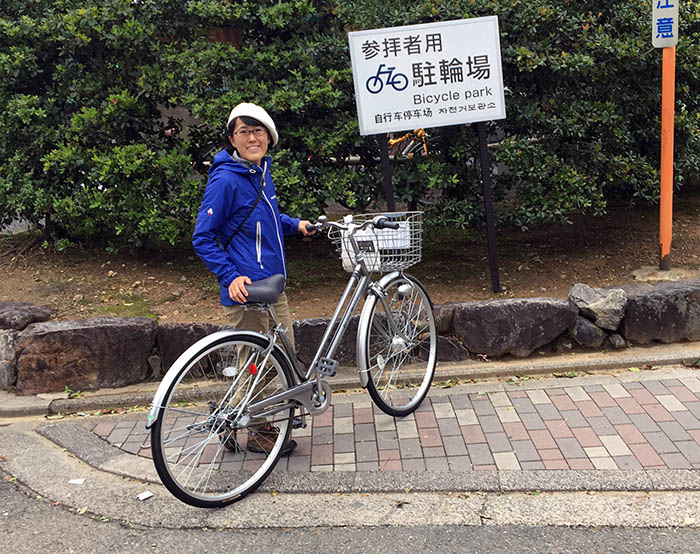
After breakfast, we headed out on two almost-new Maruishi bikes. Our first destination was the Golden Pavilion (Kinkaku-ji), one of the most famous Zen Bhuddist temples in Japan. In front of the gates, we saw signs for the bike parking lot.
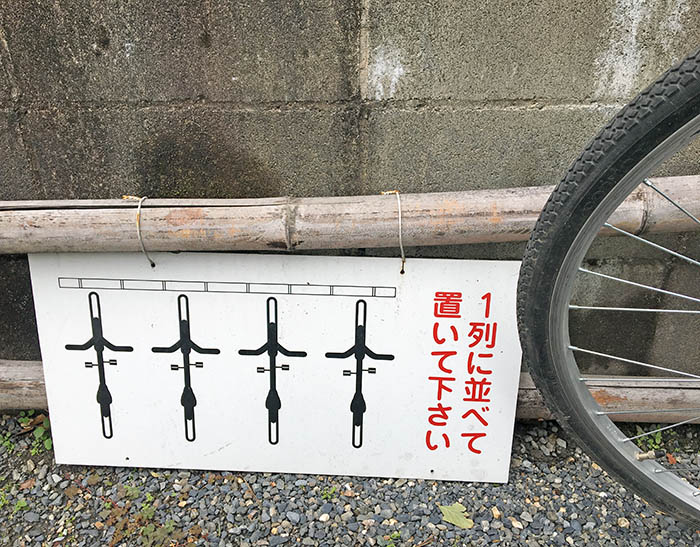
And, this being Japan, there were instructions on how to park your bike in an orderly fashion. With a sign this cute, we tried our best to line up the bikes as shown.

I didn’t know what to expect from the Golden Pavilion, but as so often in Japan, the reality exceeded anything I could have imagined. Not only are the walls of the Golden Pavilion covered in real gold, but it’s next to a lake that shows its reflection. Islands with carefully trained trees are designed to enhance the view. Even on this overcast day, the temple was luminescent, but rather than gaudy, it looked beautiful and tasteful. It took my breath away.
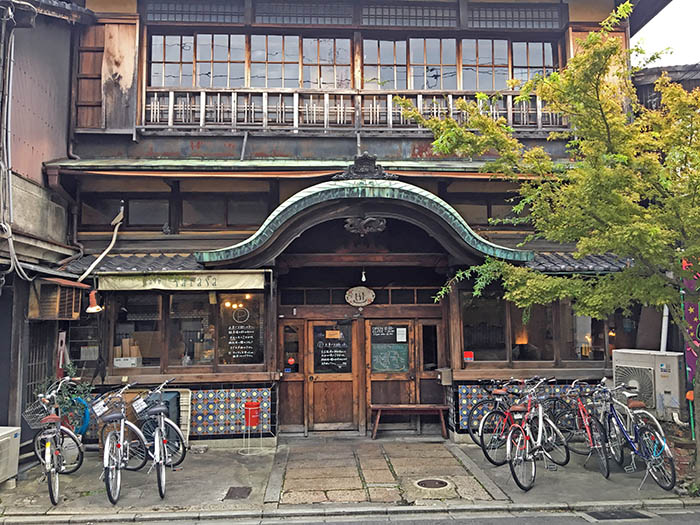
After a visit to another temple, we had lunch at an former bathhouse that had been converted to a café. It was one of the beautiful old buildings that give Kyoto its charm.
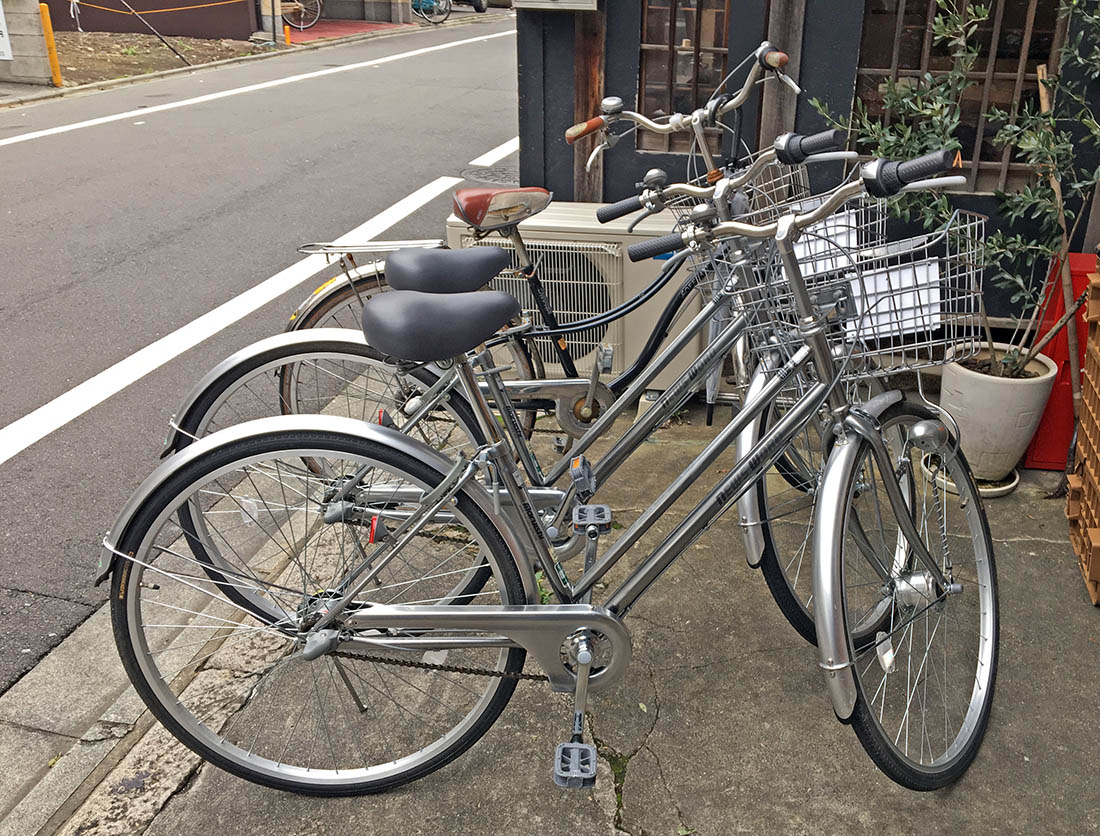
After lunch, I looked over our bikes. Japanese city bikes are designed to offer basic transportation at a very affordable price. Our Maruishis – the brand hasn’t been imported to the U.S. in decades – were among the better city bikes. They had pleasing overall lines, and the chrome-plated frames and all-silver parts added to the appeal.
A little web searching showed that this model comes in a single size, designed to fit riders over 146 cm (4’9.5″) tall. At 181 cm (5’11”), I was at the upper end of the spectrum: With the seat post extended to its maximum, the saddle was still a bit low for efficient pedaling. I noticed that most people rode their bikes that way, making it easier to put a foot down when stopping. The handlebars aren’t adjustable, so they are either high (for tall riders) or very high (for shorter ones).
These Maruishis cost just 32,800 yen (about $ 300). For that price, you get a fully equipped bike, with fenders, lights, a basket and even a lock. There is nothing else you need to buy; the bike is ready for a few years of daily use.
To understand how a fully equipped, decent-quality bike can be so inexpensive, it’s perhaps best to compare it to a car. Imagine the Maruishi as a basic Honda Civic – one of the nicer mass-produced cars, but not something an enthusiast would want to drive. The low cost is the result of designing every part to be as inexpensive and as easy to assemble as possible – while maintaining adequate quality – and then producing huge numbers. For the Maruishi, the result surprised me in many ways.
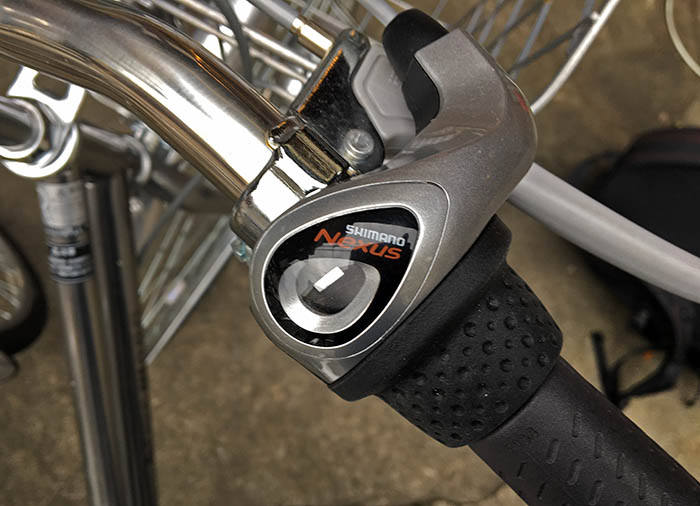
The bike comes with a Shimano Nexus three-speed hub gear that should give years of reliable service. However, the gearing was so large that I never got out of first gear! These bikes aren’t intended for riders spinning at a high cadence.
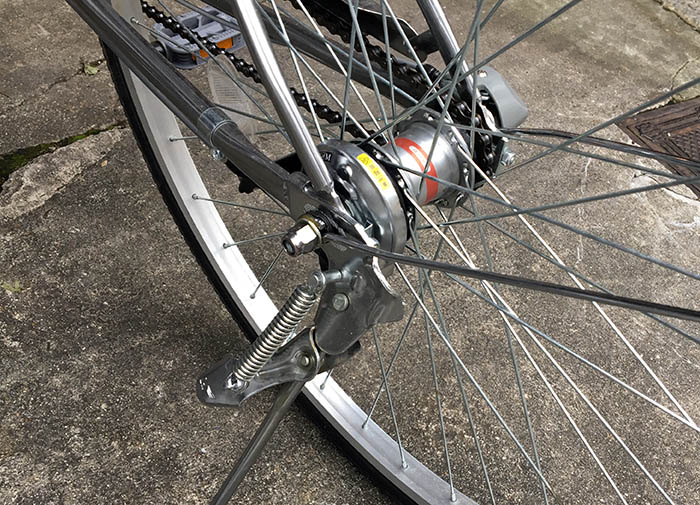
At the rear, there is a band brake that serves as the main brake. Even on our almost-new bikes, this was barely able to skid the rear wheel. Once the friction surfaces wear on these brakes, the braking power is further reduced, but the metal-on-metal friction produces a high-pitched squeal that acts as a warning: The cyclist can’t stop, but pedestrians can jump out of the way!
There is a sturdy kickstand. Frame construction is adequate – there are real dropouts, not just squished chainstays as on older German city bikes. Look carefully, and you can see the non-adjustable fender stays. The fenders are designed to fit just right, and the stays are held by the rear axle bolts.
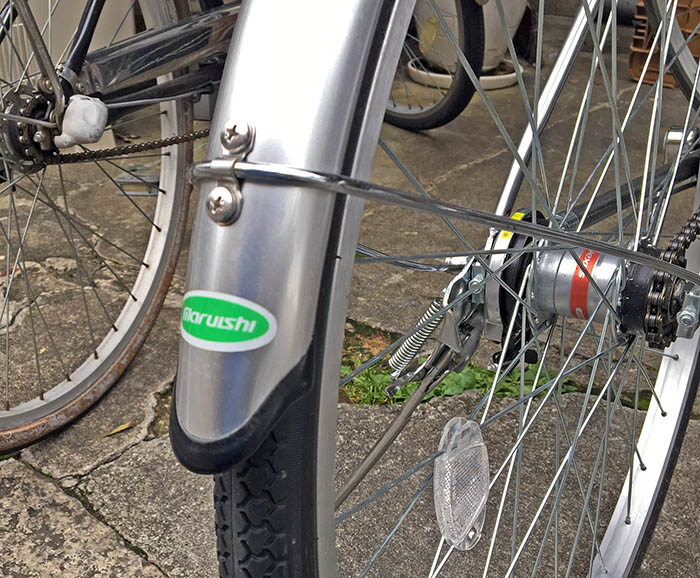
The aluminum fenders are perhaps the biggest surprise: They are made by Honjo, just like the fenders on the most expensive custom bikes. These ones don’t have a polished finish, and, while the edges are not crimped over, they are dipped in rubber to prevent cuts from sharp edges. And, as mentioned before, the stays are not adjustable, which eliminates most of the hardware. Features like these cut costs and reduce maintenance, but the function of the fenders is the same as on the more expensive Honjos we use on our own bikes: Uninterrupted interiors and rolled edges keep the water from dripping off the edges.
I’d like a little more fender coverage on the front wheel, but at the relatively low speeds of these bikes, spray from the front wheel doesn’t fly as high as it does during spirited riding, so it’s less of a problem. (And I suspect these bikes are shipped with the front wheel removed, hence the short-ish fender.) At least the fender extends far enough at the front to keep spray out of your basket…
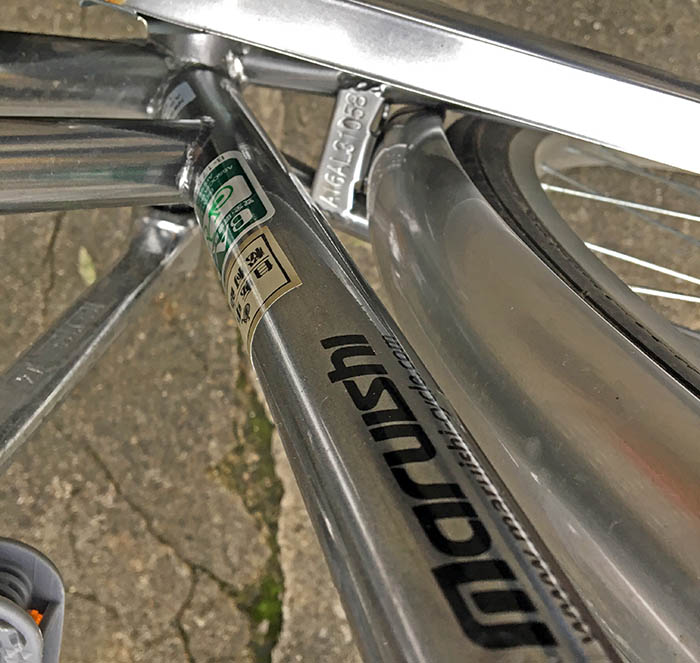
The bridges are made from stamped steel (rather than tubing), but they incorporate fender mounts. Direct fender mounting speeds up assembly; it also ensures that the fenders will neither resonate nor break prematurely. And indeed, even older Japanese city bikes are silent as they roll around the city (except for the occasional high-pitched squeal of the brakes).
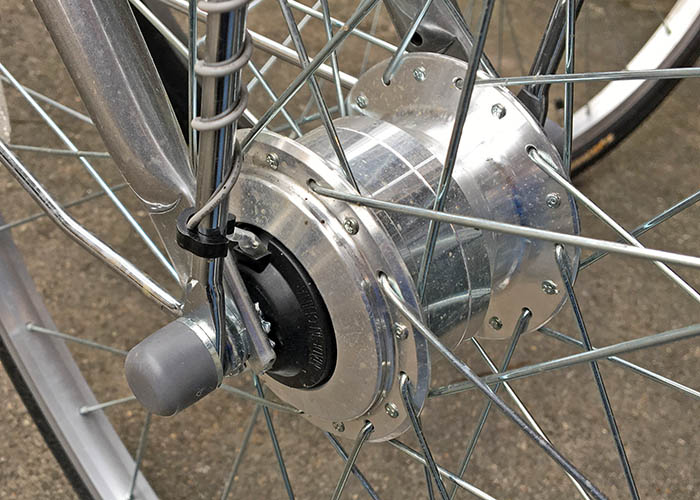
Despite its relatively low cost, the Maruishi comes standard with a generator hub. However, cost savings are evident in the fork: It doesn’t have dropouts. The ends of the fork blades are squeezed and slotted. At this price, don’t expect fine craftsmanship!
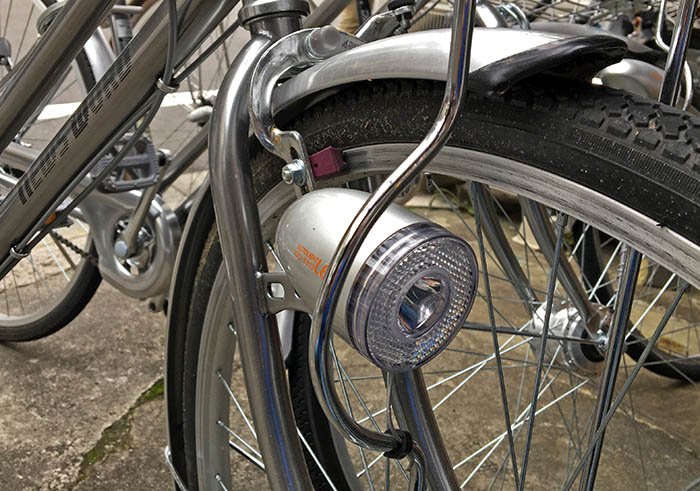
At the front, there is an LED headlight that provides sufficient illumination. The basket is permanently mounted on the bike, supported by stays that run down to the dropouts. The right stay curves around the headlight, doubling as a protector.
The front brake is a simple side pull, stamped from flat steel stock, but it worked adequately. The right lever operates the front brake, Italian- and British-style, yet most riders seem to use the rear brake, operated with the left hand. It’s not that most Japanese are left-handed, but it’s another indication that the debates over “which hand for which brake” are besides the point: It doesn’t matter!
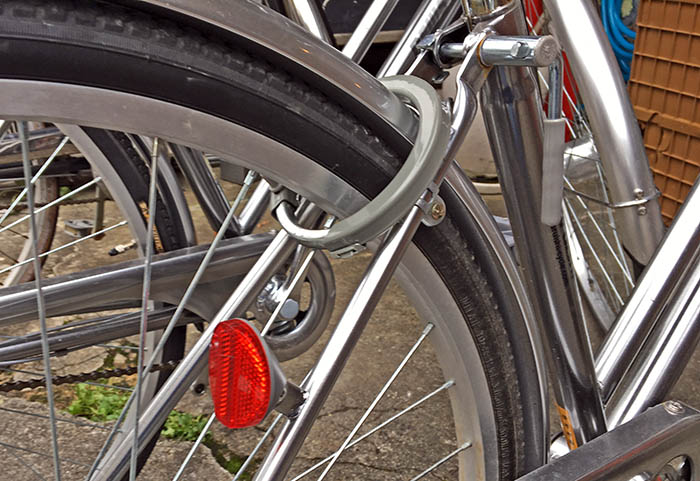
Most Japanese city bikes don’t have taillights, just a very rudimentary reflector. More often than not, this tends to go missing after a while. It’s surprising to see thousands of almost-invisible cyclists zoom around Kyoto at night, yet there seem to be very few accidents. Drivers are used to cyclists being everywhere, and with narrow streets and the need to weave around utility poles in the roadway, “distracted driving” is not an option! You can’t help but feel that despite all this apparent anarchy, it’s actually safer than riding in Seattle.
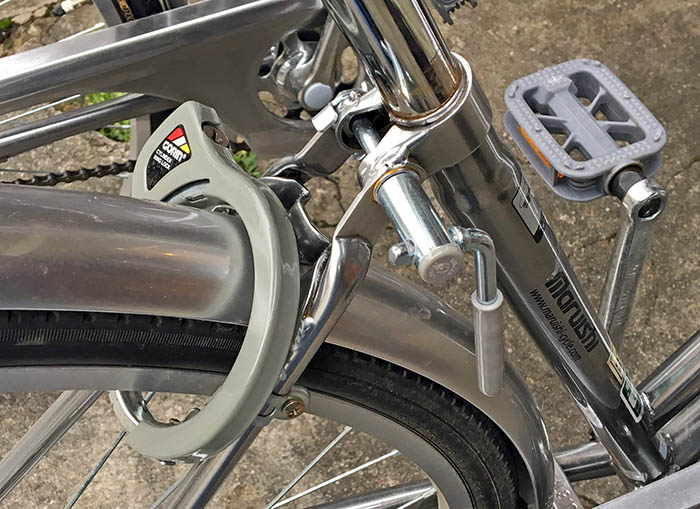
The seatpost binder bolt only looks like a quick release: It’s just a lever for turning the bolt. That makes it easy to adjust the saddle height without tools, useful when a bike is shared among several family members. (It’s like a car’s seats that are easy to adjust for different drivers.)
The lock is permanently installed. The key stays on the bike; it can be removed only after you’ve locked it by pushing the ring through the spokes. That way, there is little risk of misplacing the key. The lock provides only basic protection: Somebody could carry away the bike. But at 19.5 kg (43 lb), it’s heavy enough to defeat most would-be thieves.
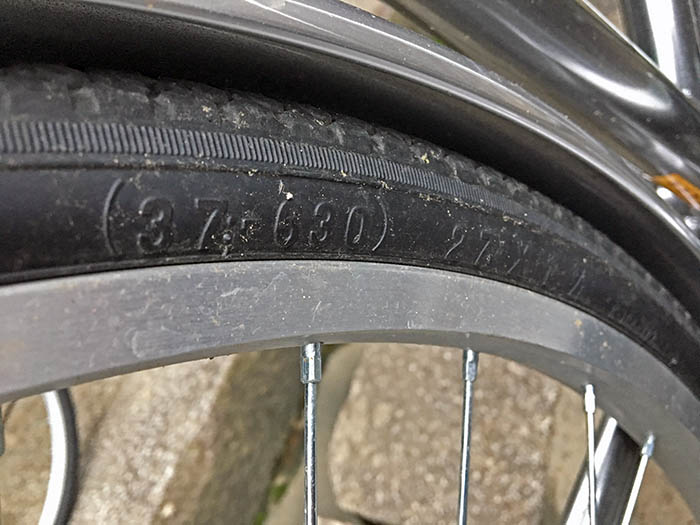 Another surprising spec: the wheels. Who said 27-inch wheels were obsolete? The tires are nominally 37 mm wide, but in reality, they probably measure closer to 32. They are sturdy Kendas, and they didn’t roll fast. Why such large wheels? I suspect it makes the bike more stable.
Another surprising spec: the wheels. Who said 27-inch wheels were obsolete? The tires are nominally 37 mm wide, but in reality, they probably measure closer to 32. They are sturdy Kendas, and they didn’t roll fast. Why such large wheels? I suspect it makes the bike more stable.
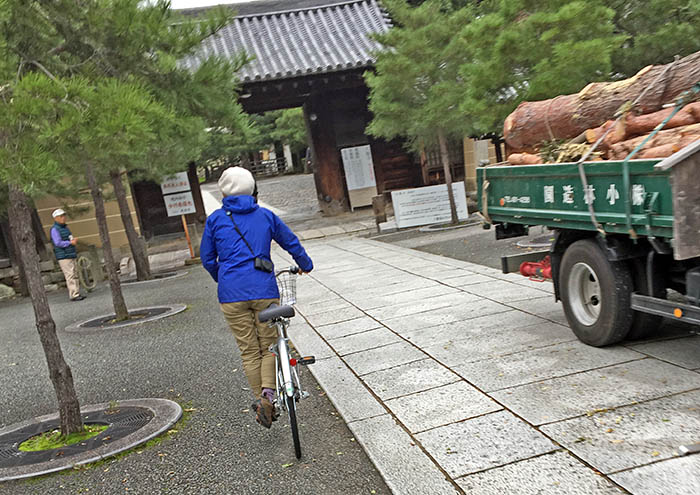
How is it to ride one of these bikes? Unusual at first! Of course, Maruishi doesn’t publish the geometry of the bike, but measuring from photos, I came up with a super-shallow head angle of 67° and a whopping 135 mm of fork offset! This results in zero trail, and thus zero wheel flop…
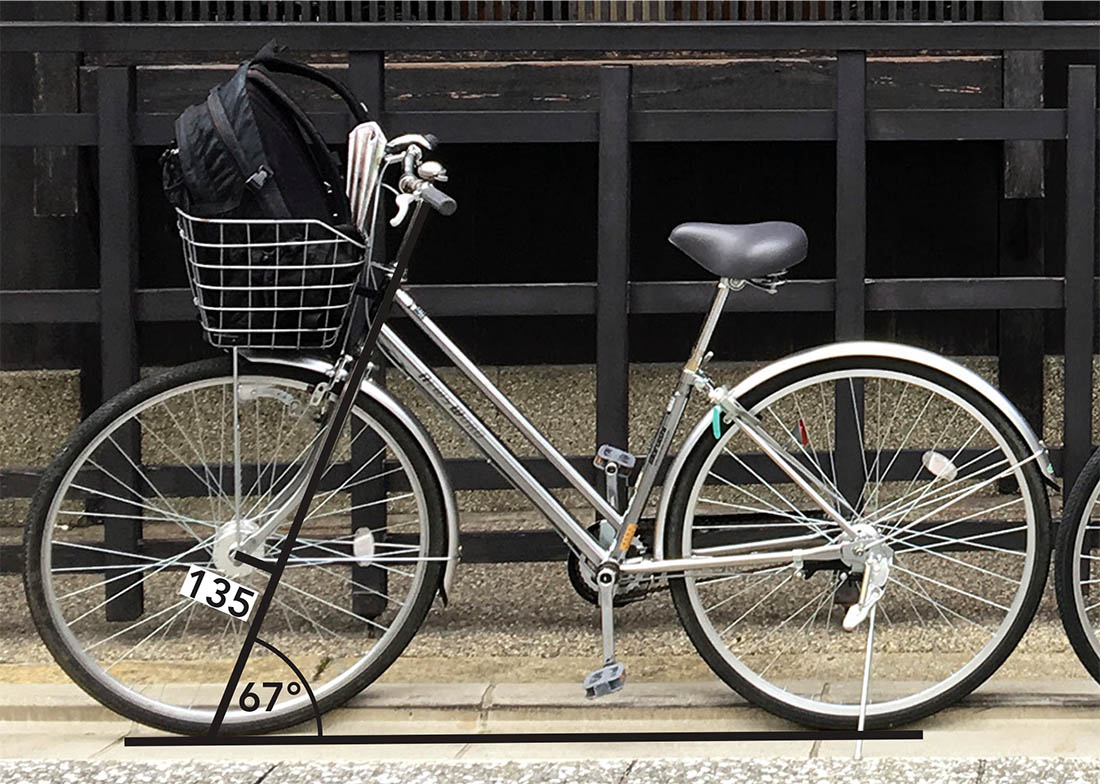
With my heavy backpack in the front basket, the fork wanted to turn even without wheel flop, and at first, it was difficult to ride in a straight line. Then I realized that the problem was my trying to guide the bike with a gentle touch. With a firm grip on the bars and my elbows locked, the bike tracked straight and handled predictably. Even rising out of the saddle – necessary for me on the hills – the bike didn’t veer off its line. With no trail, it’s easy to turn the fork to avoid a bump, but since there is no wheel flop, the movement isn’t amplified. And the large, heavy front wheel’s inertia immediately recenters the fork. Now I understand why Japanese city cyclists look wobbly, but actually move in very straight lines.
This handling trait is actually very important in the congested Japanese cities. With cars, trucks and buses passing cyclists with just inches to spare, it’s crucial not to wobble or weave! As long as cyclists move in a straight line, they are predictable, and other traffic can avoid them. As a pedestrian here in Japan, I had to learn this. When cyclists come barreling toward me on the sidewalk, I tend to freeze, figuring they will go around me. But they head straight toward me, expecting me to jump out of the way. It’s the opposite of how we do it on the trails in Seattle. I’ve realized that it doesn’t matter who moves out of the way, as long as everybody is on the same page.
One place where nobody seems to be on the same page is traffic rules. Natsuko and I are used to riding out in the country, on the left side of the road. Imagine our surprise when cyclists coming toward us sometimes moved left, sometimes right, with no rhyme or reason. Cyclists are like pedestrians here – moving at low enough speeds that they don’t crash into each other, but not bound by rules beyond common courtesy and self-preservation. We didn’t see a single cyclists wearing a helmet, yet cycling injuries in Japan are extremely rare.
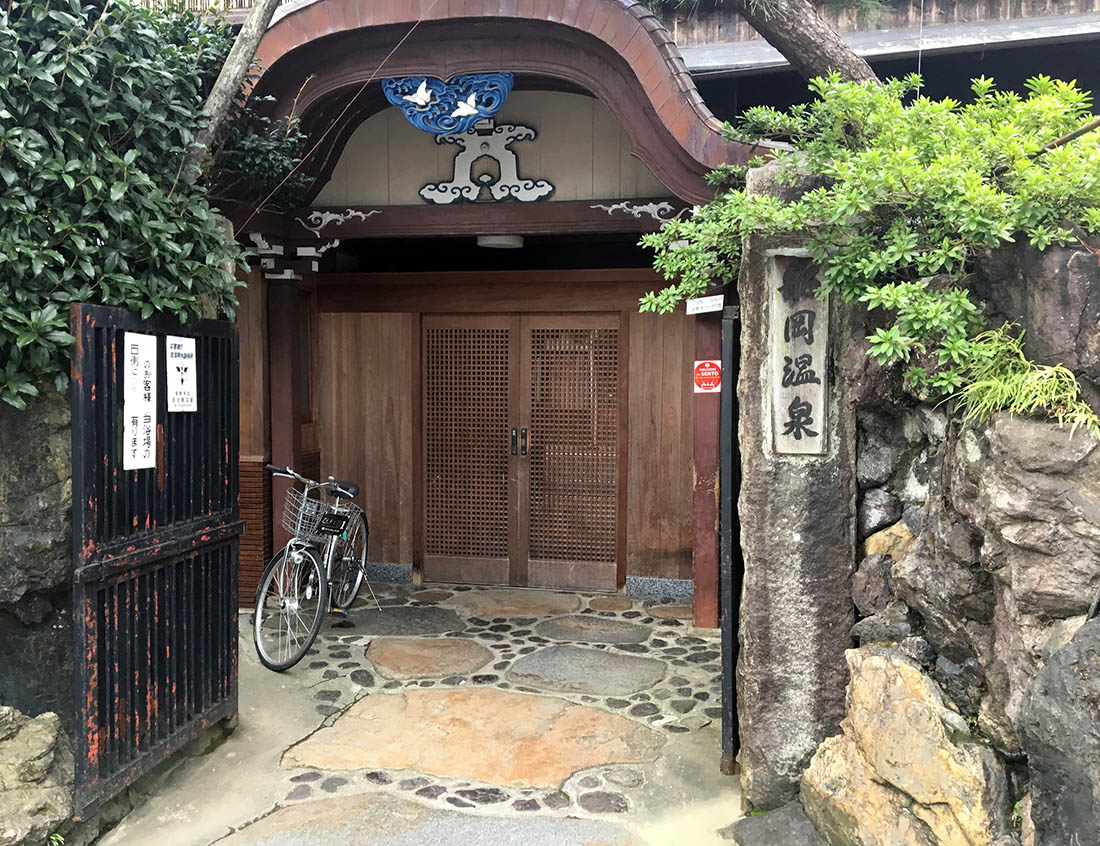
As the sun started to set on this autumn day, we headed to another public bath, this one still in operation. While I soaked in the hot water, I thought about the Maruishi. It’s a remarkable piece of engineering, designed for affordability and reliability above all. That you can buy a complete, fully-equipped bike for just $ 300 intrigues me. But then, the Maruishi’s car equivalent also offers remarkable value: If you calculated all the components of a Honda Civic at the prices charged for bicycle components, you’d end up with a price many times higher than the $ 19,000 that the Honda costs these days.
Both the Maruishi and the Civic achieve their low cost through sophisticated design and huge economies of scale. Everything on them is just ‘good enough’ for a daily user. What is remarkable is that a generator hub and high-quality fenders are among these “absolute necessities” for everyday riding. Neither the bike nor the car feature beautiful craftsmanship, but they will offer satisfactory service for those who buy them. And both feature a little extra – the Maruishi’s chrome-plated frame and the nice interior of the Honda – to instill some pride of ownership.

What if the same approach was used to make a bike for more spirited riding? Something that isn’t just for transportation, but is also fun to ride? For less than twice the price of a Civic, you can buy a real sports car, like the Mazda Miata or the Subaru BRZ. Imagine a fully equipped randonneur bike – with integrated fenders, lights and racks – for twice the price of the Maruishi! I guess you’d need to get the weight down and the performance up a bit, but even if you triple the price, you are still below $ 1,000. Imagine a bike that offers 80% of the performance and reliability of an expensive custom bike, but without any of the craftsmanship. I can’t see why this wouldn’t be possible, but it requires economies of scale that still elude the makers of performance bikes. But just think of the possibilities!


